NCERT Solutions Class 11 Chemistry Chapter 6 - Equilibrium
Q6.1: A liquid is in equilibrium with its vapour in a sealed container at a fixed temperature. The volume of the container is suddenly increased.
a) What is the initial effect of the change on vapour pressure?
b) How do rates of evaporation and condensation change initially?
c) What happens when equilibrium is restored finally and what will be the final vapour pressure?
Ans: (a) If the volume of the container is suddenly increased, then the vapour pressure would decrease initially. This is because the amount of vapour remains the same, but the volume increases suddenly. As a result, the same amount of vapour is distributed in a larger volume.
(b) Since the temperature is constant, the rate of evaporation also remains constant. When the volume of the container is increased, the density of the vapour phase decreases. As a result, the rate of collisions of the vapour particles also decreases. Hence, the rate of condensation decreases initially.
(c) When equilibrium is restored finally, the rate of evaporation becomes equal to the rate of condensation. In this case, only the volume changes while the temperature remains constant. The vapour pressure depends on temperature and not on volume. Hence, the final vapour pressure will be equal to the original vapour pressure of the system.
Q6.2: What is Kc for the following equilibrium when the equilibrium concentration of each substance is: [SO2]= 0.60 M, [O2] = 0.82 M and [SO3] = 1.90 M?
Ans: The equilibrium constant (Kc) for the give reaction is:

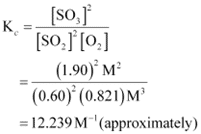
Hence, Kcfor the equilibrium is  .
.
Q6.3: At a certain temperature and total pressure of 105 Pa, iodine vapour contains 40% by volume of I atoms  . Calculate Kp for the equilibrium.
. Calculate Kp for the equilibrium.
Ans: Partial pressure of I atoms,


Partial pressure of I2 molecules,


Now, for the given reaction,
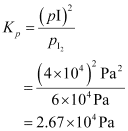
Q6.4: Write the expression for the equilibrium constant, Kc for each of the following reactions:
Ans:
(i)
(ii)
(iii)
(iv)
(v)
Q6.5: Find out the value of Kc for each of the following equilibria from the value of Kp:
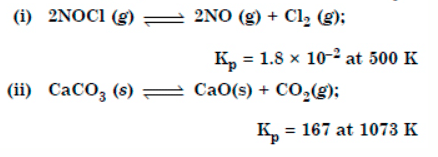
Ans: The relation between Kp and Kc is given as:
Kp = Kc (RT)Δn
(a) Here, Δn = 3 – 2 = 1
R = 0.0831 barLmol–1K–1
T = 500 K
Kp = 1.8 × 10–2
Now,
Kp = Kc (RT) Δn
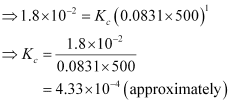
(b) Here, Δn = 2 – 1 = 1
R = 0.0831 barLmol–1K–1
T = 1073 K
Kp= 167
Now,
Kp = Kc (RT) Δn

Q6.6: For the following equilibrium, 

Both the forward and reverse reactions in the equilibrium are elementary bimolecular reactions. What is Kc, for the reverse reaction?
Ans:
It is given that KC for the forward reaction is 6.3 X1014.
Then, KC for the reverse reaction will be,
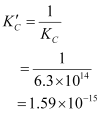
Q6.7: Explain why pure liquids and solids can be ignored while writing the equilibrium constant expression?
Ans: For a pure substance (both solids and liquids),

Now, the molecular mass and density (at a particular temperature) of a pure substance is always fixed and is accounted for in the equilibrium constant. Therefore, the values of pure substances are not mentioned in the equilibrium constant expression.
Q6.8: Reaction between N2 and O2 takes place as follows:
If a mixture of 0.482 mol of N2 and 0.933 mol of O2 is placed in a 10 L reaction vessel and allowed to form N2O at a temperature for which Kc = 2.0 × 10–37, determine the composition of equilibrium mixture.
Ans: Let the concentration of N2O at equilibrium be x.
The given reaction is:

Therefore, at equilibrium, in the 10 L vessel:

The value of equilibrium constant i.e.,  = 2.0 × 10–37 is very small. Therefore, the amount of N2 and O2 reacted is also very small. Thus, x can be neglected from the expressions of molar concentrations of N2 and O2.
= 2.0 × 10–37 is very small. Therefore, the amount of N2 and O2 reacted is also very small. Thus, x can be neglected from the expressions of molar concentrations of N2 and O2.
Then,

Now,
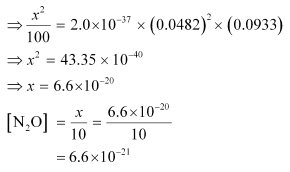
Q6.9: Nitric oxide reacts with Br2 and gives nitrosyl bromide as per reaction given below:
When 0.087 mol of NO and 0.0437 mol of Br2 are mixed in a closed container at constant temperature, 0.0518 mol of NOBr is obtained at equilibrium. Calculate equilibrium amount of NO and Br2.
Ans:
The given reaction is:

Now, 2 mol of NOBr are formed from 2 mol of NO. Therefore, 0.0518 mol of NOBr are formed from 0.0518 mol of NO.
Again, 2 mol of NOBr are formed from 1 mol of Br.
Therefore, 0.0518 mol of NOBr are formed from  mol of Br, or
mol of Br, or
0.0259 mol of NO.
The amount of NO and Br present initially is as follows:
[NO] = 0.087 mol [Br2] = 0.0437 mol
Therefore, the amount of NO present at equilibrium is:
[NO] = 0.087 – 0.0518
= 0.0352 mol
And, the amount of Br present at equilibrium is:
[Br2] = 0.0437 – 0.0259
= 0.0178 mol
Q6.10: At 450 K, Kp= 2.0 × 1010/bar for the given reaction at equilibrium.

What is Kc at this temperature?
Ans: For the given reaction,
Δn = 2 – 3 = – 1
T = 450 K
R = 0.0831 bar L bar K–1 mol–1
= 2.0 × 1010 bar –1
We know that,

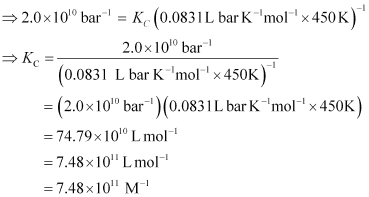
Q6.11: A sample of HI(g) is placed in flask at a pressure of 0.2 atm. At equilibrium the partial pressure of HI(g) is 0.04 atm. What is Kp for the given equilibrium?

Ans:
The initial concentration of HI is 0.2 atm. At equilibrium, it has a partial pressure of 0.04 atm. Therefore, a decrease in the pressure of HI is 0.2 – 0.04 = 0.16. The given reaction is:

Therefore,
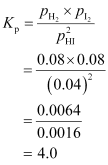
Hence, the value of Kp for the given equilibrium is 4.0.
Q6.12: A mixture of 1.57 mol of N2, 1.92 mol of H2 and 8.13 mol of NH3 is introduced into a 20 L reaction vessel at 500 K. At this temperature, the equilibrium constant, Kc for the reaction

Is the reaction mixture at equilibrium? If not, what is the direction of the net reaction?
Ans:
The given reaction is:

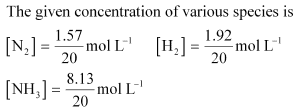
Now, reaction quotient Qc is:
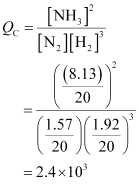
Since  , the reaction mixture is not at equilibrium.
, the reaction mixture is not at equilibrium.
Again,  . Hence, the reaction will proceed in the reverse direction.
. Hence, the reaction will proceed in the reverse direction.
Q6.13: The equilibrium constant expression for a gas reaction is,

Write the balanced chemical equation corresponding to this expression.
Ans: The balanced chemical equation corresponding to the given expression can be written as:

Q6.14: One mole of H2O and one mole of CO are taken in 10 L vessel and heated to 725 K. At equilibrium 40% of water (by mass) reacts with CO according to the equation,

Calculate the equilibrium constant for the reaction.
Ans: The given reaction is:

Therefore, the equilibrium constant for the reaction,
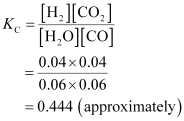
Q6.15: At 700 K, equilibrium constant for the reaction

is 54.8. If 0.5 molL–1 of HI(g) is present at equilibrium at 700 K, what are the concentration of H2(g) and I2(g) assuming that we initially started with HI(g) and allowed it to reach equilibrium at 700 K?
Ans:
It is given that equilibrium constant  for the reaction
for the reaction
 is 54.8.
is 54.8.
Therefore, at equilibrium, the equilibrium constant  for the reaction
for the reaction
 will be
will be  .
.

Let the concentrations of hydrogen and iodine at equilibrium be x molL–1
.

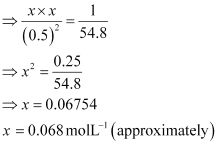
Hence, at equilibrium, 
Q6.16: What is the equilibrium concentration of each of the substances in the equilibrium when the initial concentration of ICl was 0.78 M?

Ans:
The given reaction is:


Hence, at equilibrium,

Q6.17: Kp = 0.04 atm at 899 K for the equilibrium shown below. What is the equilibrium concentration of C2H6 when it is placed in a flask at 4.0 atm pressure and allowed to come to equilibrium?

Ans: Let p be the pressure exerted by ethene and hydrogen gas (each) at equilibrium.
Now, according to the reaction,

We can write,
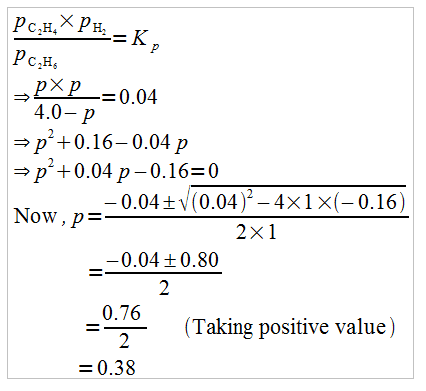
Hence, at equilibrium,

Q6.18: Ethyl acetate is formed by the reaction between ethanol and acetic acid and the equilibrium is represented as:

(i) Write the concentration ratio (reaction quotient), Qc, for this reaction (note: water is not in excess and is not a solvent in this reaction)
(ii) At 293 K, if one starts with 1.00 mol of acetic acid and 0.18 mol of ethanol, there is 0.171 mol of ethyl acetate in the final equilibrium mixture. Calculate the equilibrium constant.
(iii) Starting with 0.5 mol of ethanol and 1.0 mol of acetic acid and maintaining it at 293 K, 0.214 mol of ethyl acetate is found after sometime. Has equilibrium been reached?
Ans: (i) Reaction quotient, 
(ii) Let the volume of the reaction mixture be V. Also, here we will consider that water is a solvent and is present in excess.
The given reaction is:
Therefore, equilibrium constant for the given reaction is:

(iii) Let the volume of the reaction mixture be V.
Therefore, the reaction quotient is,
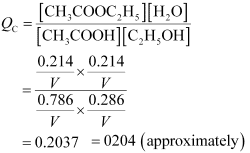
Since  , equilibrium has not been reached.
, equilibrium has not been reached.
Q6.19: A sample of pure PCl5 was introduced into an evacuated vessel at 473 K. After equilibrium was attained, concentration of PCl5 was found to be 0.5 × 10–1 mol L–1. If value of Kcis 8.3 × 10–3, what are the concentrations of PCl3 and Cl2 at equilibrium?

Ans: Let the concentrations of both PCl3 and Cl2 at equilibrium be x molL–1. The given reaction is:

Now we can write the expression for equilibrium as:
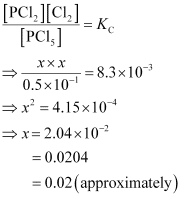
Therefore, at equilibrium,

Q6.20: One of the reactions that takes place in producing steel from iron ore is the reduction of iron (II) oxide by carbon monoxide to give iron metal and CO2.
FeO (s) CO (g) Fe (s) CO2 (g); Kp= 0.265 at 1050 K.
What are the equilibrium partial pressures of CO and CO2 at 1050 K if the initial partial pressures are: pCO = 1.4 atm and  = 0.80 atm?
= 0.80 atm?
Ans: For the given reaction,

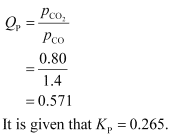
Since  , the reaction will proceed in the backward direction.
, the reaction will proceed in the backward direction.
Therefore, we can say that the pressure of CO will increase while the pressure of CO2 will decrease.
Now, let the increase in pressure of CO = decrease in pressure of CO2 be p.
Then, we can write,
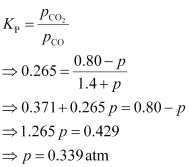
Therefore, equilibrium partial of 
And, equilibrium partial pressure of 
Q6.21: Equilibrium constant, Kc for the reaction
 at 500 K is 0.061.
at 500 K is 0.061.
At a particular time, the analysis shows that composition of the reaction mixture is 3.0 mol L–1 N2, 2.0 mol L–1 H2 and 0.5 mol L–1 NH3. Is the reaction at equilibrium? If not in which direction does the reaction tend to proceed to reach equilibrium?
Ans: The given reaction is:

Now, we know that,

Since  , the reaction is not at equilibrium.
, the reaction is not at equilibrium.
Since  , the reaction will proceed in the forward direction to reach equilibrium.
, the reaction will proceed in the forward direction to reach equilibrium.
Q6.22: Bromine monochloride, BrCl decomposes into bromine and chlorine and reaches the equilibrium: 
for which Kc = 32 at 500 K. If initially pure BrCl is present at a concentration of 3.3 × 10–3 molL–1, what is its molar concentration in the mixture at equilibrium?
Ans: Let the amount of bromine and chlorine formed at equilibrium be x. The given reaction is:

Now, we can write,
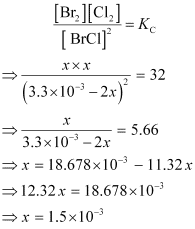
Therefore, at equilibrium,

Q6.23: At 1127 K and 1 atm pressure, a gaseous mixture of CO and CO2 in equilibrium with solid carbon has 90.55% CO by mass

Calculate Kc for this reaction at the above temperature.
Ans: Let the total mass of the gaseous mixture be 100 g.
Mass of CO = 90.55 g
And, mass of CO2 = (100 – 90.55) = 9.45 g
Now, number of moles of CO, 
Number of moles of CO2, 
Partial pressure of CO,
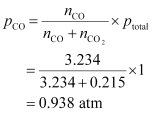
Partial pressure of CO2,
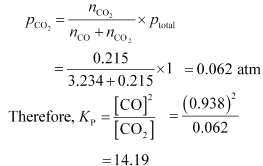
For the given reaction,
Δn = 2 – 1 = 1
We know that,
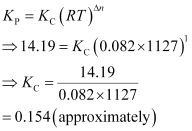
Q6.24: Calculate a) ΔG°and b) the equilibrium constant for the formation of NO2 from NO and O2 at 298 K

where ΔfG° (NO2) = 52.0 kJ/mol
ΔfG° (NO) = 87.0 kJ/mol
ΔfG° (O2) = 0 kJ/mol
Ans:
(a) For the given reaction,
ΔG° = ΔG°( Products) – ΔG°( Reactants)
ΔG° = 52.0 – {87.0 0}
= – 35.0 kJ mol–1
(b) We know that,
ΔG° = RT log Kc
ΔG° = 2.303 RT log Kc
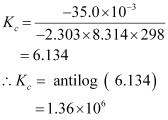
Hence, the equilibrium constant for the given reaction Kc is 1.36 × 106
Q6.25: Does the number of moles of reaction products increase, decrease or remain same when each of the following equilibria is subjected to a decrease in pressure by increasing the volume?
(a) 
(b) 
(c) 
Ans:
(a) The number of moles of reaction products will increase. According to Le Chatelier’s principle, if pressure is decreased, then the equilibrium shifts in the direction in which the number of moles of gases is more. In the given reaction, the number of moles of gaseous products is more than that of gaseous reactants. Thus, the reaction will proceed in the forward direction. As a result, the number of moles of reaction products will increase.
(b) The number of moles of reaction products will decrease.
(c) The number of moles of reaction products remains the same.
Q6.26: Which of the following reactions will get affected by increasing the pressure? Also, mention whether change will cause the reaction to go into forward or backward direction.
(i)
(ii) 
(iii) 
(iv) 
(v) 
(vi) 
Ans: The reactions given in (i), (iii), (iv), (v), and (vi) will get affected by increasing the pressure.
The reaction given in (iv) will proceed in the forward direction because the number of moles of gaseous reactants is more than that of gaseous products.
The reactions given in (i), (iii), (v), and (vi) will shift in the backward direction because the number of moles of gaseous reactants is less than that of gaseous products.
Q6.27: The equilibrium constant for the following reaction is 1.6 ×105 at 1024 K.

Find the equilibrium pressure of all gases if 10.0 bar of HBr is introduced into a sealed container at 1024 K.
Ans: Given,
 for the reaction i.e.,
for the reaction i.e., 
Therefore, for the reaction  the equilibrium constant will be,
the equilibrium constant will be,
Now, let p be the pressure of both H2 and Br2 at equilibrium.

Now, we can write,
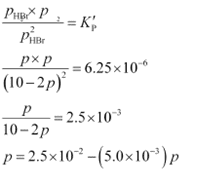

Therefore, at equilibrium,

Q6.28: Dihydrogen gas is obtained from natural gas by partial oxidation with steam as per following endothermic reaction:

(a) Write as expression for Kp for the above reaction.
(b) How will the values of Kp and composition of equilibrium mixture be affected by
(i) Increasing the pressure
(ii) Increasing the temperature
(iii) Using a catalyst?
Ans: (a) For the given reaction,

(b) (i) According to Le Chatelier’s principle, the equilibrium will shift in the backward direction.
(ii) According to Le Chatelier’s principle, as the reaction is endothermic, the equilibrium will shift in the forward direction.
(iii) The equilibrium of the reaction is not affected by the presence of a catalyst. A catalyst only increases the rate of a reaction. Thus, equilibrium will be attained quickly.
Q6.29: Describe the effect of:
(a) Addition of H2
(b) Addition of CH3OH
(c) Removal of CO
(d) Removal of CH3OH
on the equilibrium of the reaction:

Ans:
(a) According to Le Chatelier’s principle, on addition of H2, the equilibrium of the given reaction will shift in the forward direction.
(b) On addition of CH3OH, the equilibrium will shift in the backward direction.
(c) On removing CO, the equilibrium will shift in the backward direction.
(d) On removing CH3OH, the equilibrium will shift in the forward direction.
Q6.30: At 473 K, equilibrium constant Kc for decomposition of phosphorus pentachloride, PCl5 is 8.3 ×10-3. If decomposition is depicted as,

ΔrH° = 124.0 kJmol–1
(a) Write an expression for Kc for the reaction.
(b) What is the value of Kc for the reverse reaction at the same temperature?
(c) What would be the effect on Kc if (i) more PCl5 is added (ii) pressure is increased? (iii) The temperature is increased?
Ans:
(a)
(b) Value of Kc for the reverse reaction at the same temperature is:
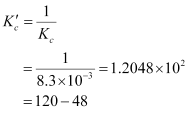
(c) (i) Kc would remain the same because in this case, the temperature remains the same.
(ii) Kc is constant at constant temperature. Thus, in this case, Kc would not change.
(iii) In an endothermic reaction, the value of Kc increases with an increase in temperature. Since the given reaction in an endothermic reaction, the value of Kc will increase if the temperature is increased.
Q6.31: Dihydrogen gas used in Haber’s process is produced by reacting methane from natural gas with high temperature steam. The first stage of two stage reaction involves the formation of CO and H2. In second stage, CO formed in first stage is reacted with more steam in water gas shift reaction,

If a reaction vessel at 400°C is charged with an equimolar mixture of CO and steam such that  4.0 bar, what will be the partial pressure of H2 at equilibrium? Kp= 10.1 at 400°C
4.0 bar, what will be the partial pressure of H2 at equilibrium? Kp= 10.1 at 400°C
Ans: Let the partial pressure of both carbon dioxide and hydrogen gas be p. The given reaction is:
Now
Hence, at equilibrium, the partial pressure of H2 will be 3.04 bar.
Q6.32: Predict which of the following reaction will have appreciable concentration of reactants and products:
a) 
b) 
c) 
Ans: If the value of Kc lies between 10–3 and 103, a reaction has appreciable concentration of reactants and products. Thus, the reaction given in (c) will have appreciable concentration of reactants and products.
Q6.33: The value of Kc for the reaction 3O2 (g)  2O3 (g) is 2.0 ×10–50 at 25°C. If the equilibrium concentration of O2 in air at 25°C is 1.6 ×10–2, what is the concentration of O3?
2O3 (g) is 2.0 ×10–50 at 25°C. If the equilibrium concentration of O2 in air at 25°C is 1.6 ×10–2, what is the concentration of O3?
Ans: The given reaction is:
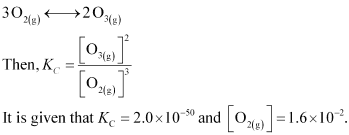
Then, we have,
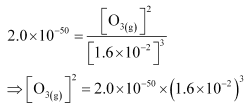

Hence, the concentration of 
Q6.34: The reaction, CO(g) +3H2(g) CH4(g) +H2O(g) is at equilibrium at 1300 K in a 1L flask. It also contain 0.30 mol of CO, 0.10 mol of H2 and 0.02 mol of H2O and an unknown amount of CH4 in the flask. Determine the concentration of CH4 in the mixture. The equilibrium constant, Kc for the reaction at the given temperature is 3.90.
CH4(g) +H2O(g) is at equilibrium at 1300 K in a 1L flask. It also contain 0.30 mol of CO, 0.10 mol of H2 and 0.02 mol of H2O and an unknown amount of CH4 in the flask. Determine the concentration of CH4 in the mixture. The equilibrium constant, Kc for the reaction at the given temperature is 3.90.
Ans: Let the concentration of methane at equilibrium be x.

It is given that Kc = 3.90.
Therefore,
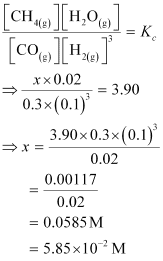
Hence, the concentration of CH4 at equilibrium is 5.85 × 10–2 M.
Q6.35: What is meant by the conjugate acid-base pair? Find the conjugate acid/base for the following species:

Ans: A conjugate acid-base pair is a pair that differs only by one proton.
The conjugate acid-base for the given species is mentioned in the table below.
Q6.36: Which of the followings are Lewis acids? H2O, BF3, H+, and 
Ans: Lewis acids are those acids which can accept a pair of electrons. For example, BF3, H+, and  are Lewis acids.
are Lewis acids.
Q6.37: What will be the conjugate bases for the Brönsted acids: HF, H2SO4 and HCO3?
Ans: The table below lists the conjugate bases for the given Bronsted acids.
Q6.38: Write the conjugate acids for the following Brönsted bases: NH2–, NH3 and HCOO–.
Ans: The table below lists the conjugate acids for the given Bronsted bases.
Q6.39: The species: H2O,  and NH3 can act both as Brönsted acids and bases. For each case give the corresponding conjugate acid and base.
and NH3 can act both as Brönsted acids and bases. For each case give the corresponding conjugate acid and base.
Ans: The table below lists the conjugate acids and conjugate bases for the given species.
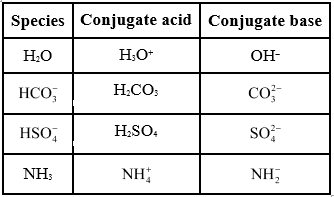
Q6.40: Classify the following species into Lewis acids and Lewis bases and show how these act as Lewis acid/base: (a) OH– (b) F– (c) H+ (d) BCl3.
Ans: (a) OH– is a Lewis base since it can donate its lone pair of electrons.
(b) F– is a Lewis base since it can donate a pair of electrons.
(c) H+ is a Lewis acid since it can accept a pair of electrons.
(d) BCl3 is a Lewis acid since it can accept a pair of electrons.
Q6.41: The concentration of hydrogen ion in a sample of soft drink is 3.8 × 10–3 M. what is its pH?
Ans: Given,

pH value of soft drink

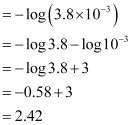
Q6.42: The pH of a sample of vinegar is 3.76. Calculate the concentration of hydrogen ion in it.
Ans: Given,
pH = 3.76
It is known that,
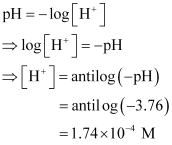
Hence, the concentration of hydrogen ion in the given sample of vinegar is 1.74 × 10–4 M.
Q6.43: The ionization constant of HF, HCOOH and HCN at 298K are 6.8 × 10–4, 1.8 × 10–4 and 4.8 × 10–9 respectively. Calculate the ionization constants of the corresponding conjugate base.
Ans: It is known that,
Given,
Ka of HF = 6.8 × 10–4
Hence, Kb of its conjugate base F–

Given,
Ka of HCOOH = 1.8 × 10–4
Hence, Kb of its conjugate base HCOO–


Given,
Ka of HCN = 4.8 × 10–9
Hence, Kb of its conjugate base CN–


Q6.44: The ionization constant of phenol is 1.0×10–10. What is the concentration of phenolate ion in 0.05M solution of phenol? What will be its degree of ionization if the solution is also 0.01M in sodium phenolate?
Ans: Ionization of phenol:
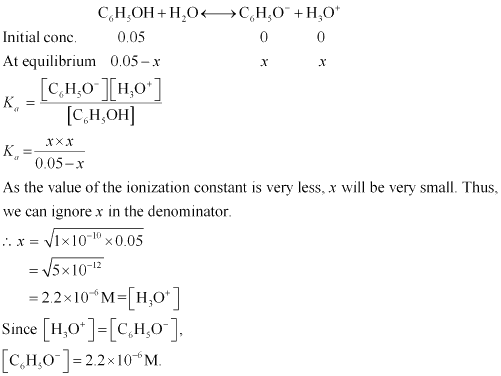
Now, let ∝ be the degree of ionization of phenol in the presence of 0.01 M C6H5ONa.

Also,




Q6.45: The first ionization constant of H2S is 9.1 × 10–8. Calculate the concentration of HS– ion in its 0.1 M solution. How will this concentration be affected if the solution is 0.1 M in HCl also? If the second dissociation constant of H2S is 1.2 × 10–13, calculate the concentration of S2– under both conditions.
Ans: (i) To calculate the concentration of HS– ion:
Case I (in the absence of HCl):
Let the concentration of HS– be x M.
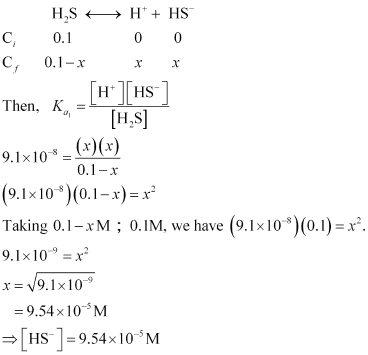
Case II (in the presence of HCl):
In the presence of 0.1 M of HCl, let  be y M.
be y M.


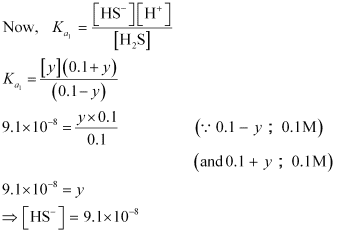
(ii) To calculate the concentration of  :
:
Case I (in the absence of 0.1 M HCl):

 (From first ionization, case I)
(From first ionization, case I)
Let 
Also,  (From first ionization, case I)
(From first ionization, case I)
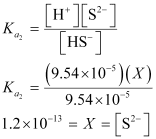
Case II (in the presence of 0.1 M HCl):
Again, let the concentration of HS– be X' M.
 (From first ionization, case II)
(From first ionization, case II)
 (From HCl, case II)
(From HCl, case II)
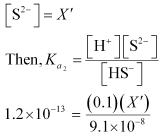
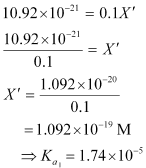
Q6.46: The ionization constant of acetic acid is 1.74 × 10–5. Calculate the degree of dissociation of acetic acid in its 0.05 M solution. Calculate the concentration of acetate ion in the solution and its pH.
Ans: Method 1

Since Ka >> Kw, :
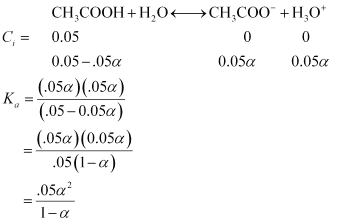
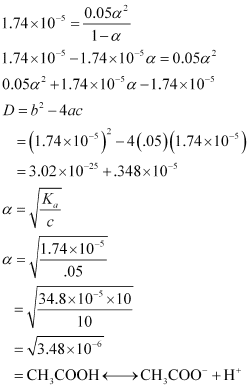

Method 2
Degree of dissociation,

c = 0.05 M
Ka = 1.74 × 10–5

Thus, concentration of CH3COO– = c.α

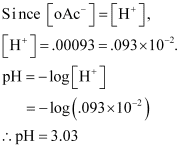
Hence, the concentration of acetate ion in the solution is 0.00093 M and its Ph is 3.03.
Q6.47: It has been found that the pH of a 0.01M solution of an organic acid is 4.15. Calculate the concentration of the anion, the ionization constant of the acid and its pKa.
Ans: Let the organic acid be HA.


Concentration of HA = 0.01 M
pH = 4.15

Now, 

Then,

Q6.48: Assuming complete dissociation, calculate the pH of the following solutions:
(a) 0.003 M HCl (b) 0.005 M NaOH (c) 0.002 M HBr (d) 0.002 M KOHAns: (a) 0.003MHCl:

Since HCl is completely ionized,

Now,

Hence, the pH of the solution is 2.52.
(b) 0.005MNaOH:

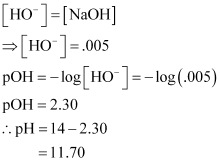
Hence, the pH of the solution is 11.70.
(c) 0.002 HBr:

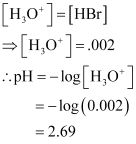
Hence, the pH of the solution is 2.69.
(d) 0.002 M KOH:

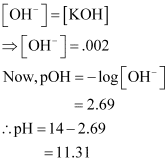
Hence, the pH of the solution is 11.31.
Q6.49: Calculate the pH of the following solutions:
a) 2 g of TlOH dissolved in water to give 2 litre of solution.b) 0.3 g of Ca(OH)2 dissolved in water to give 500 mL of solution.
c) 0.3 g of NaOH dissolved in water to give 200 mL of solution.d) 1mL of 13.6 M HCl is diluted with water to give 1 litre of solution.
Ans: (a) For 2g of TlOH dissolved in water to give 2 L of solution:
(b) For 0.3 g of Ca(OH)2 dissolved in water to give 500 mL of solution:



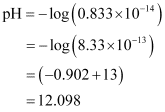
(c) For 0.3 g of NaOH dissolved in water to give 200 mL of solution:

(d) For 1mL of 13.6 M HCl diluted with water to give 1 L of solution:
13.6 × 1 mL = M2 × 1000 mL
(Before dilution) (After dilution)
13.6 × 10–3 = M2 × 1L
M2 = 1.36 × 10–2
[H ] = 1.36 × 10–2
pH = – log (1.36 × 10–2)
= (– 0.1335 2) = 1.866 ∼ 1.87
Q6.50: The degree of ionization of a 0.1M bromoacetic acid solution is 0.132. Calculate the pH of the solution and the pKa of bromoacetic acid.
Ans: Degree of ionization, α = 0.132
Concentration, c = 0.1 M
Thus, the concentration of H3O = c.α
= 0.1 × 0.132
= 0.0132

Now,
Q6.51: The pH of 0.005M codeine (C18H21NO3) solution is 9.95. Calculate its ionization constant and pKb.
Ans:
c = 0.005
pH = 9.95
pOH = 4.05
pH = – log (4.105)
Q6.52: What is the pH of 0.001 M aniline solution? The ionization constant of aniline can be taken from Table 7.7. Calculate the degree of ionization of aniline in the solution. Also calculate the ionization constant of the conjugate acid of aniline.
Ans:
Kb = 4.27 × 10–10
c = 0.001M
pH =?
α =?
Thus, the ionization constant of the conjugate acid of aniline is 2.34 × 10–5.
Q6.53: Calculate the degree of ionization of 0.05M acetic acid if its pKa value is 4.74. How is the degree of dissociation affected when its solution also contains (a) 0.01 M (b) 0.1 M in HCl?
Ans:
When HCl is added to the solution, the concentration of H+ ions will increase. Therefore, the equilibrium will shift in the backward direction i.e., dissociation of acetic acid will decrease.
Case I: When 0.01 M HCl is taken.
Let x be the amount of acetic acid dissociated after the addition of HCl.
As the dissociation of a very small amount of acetic acid will take place, the values i.e., 0.05 – x and 0.01 + x can be taken as 0.05 and 0.01 respectively.
Case II: When 0.1 M HCl is taken.
Let the amount of acetic acid dissociated in this case be X. As we have done in the first case, the concentrations of various species involved in the reaction are:
Q6.54: The ionization constant of dimethylamine is 5.4 × 10–4. Calculate its degree of ionization in its 0.02 M solution. What percentage of dimethylamine is ionized if the solution is also 0.1 M in NaOH?
Ans:
Now, if 0.1 M of NaOH is added to the solution, then NaOH (being a strong base) undergoes complete ionization.
It means that in the presence of 0.1 M NaOH, 0.54% of dimethylamine will get dissociated.
Q6.55: Calculate the hydrogen ion concentration in the following biological fluids whose pH are given below:
(a) Human muscle-fluid, 6.83
(b) Human stomach fluid, 1.2
(c) Human blood, 7.38
(d) Human saliva, 6.4.
Ans:
(a) Human muscle fluid 6.83:
pH = 6.83
pH = – log [H+]
∴6.83 = – log [H+]
[H+] =1.48 × 10–7 M
(b) Human stomach fluid, 1.2:
pH =1.2
1.2 = – log [H+]
∴[H+] = 0.063
(c) Human blood, 7.38:
pH = 7.38 = – log [H+]
∴ [H+] = 4.17 × 10–8 M
(d) Human saliva, 6.4:
pH = 6.4
6.4 = – log [H+]
[H+] = 3.98 × 10–7
Q6.56: The pH of milk, black coffee, tomato juice, lemon juice and egg white are 6.8, 5.0, 4.2, 2.2 and 7.8 respectively. Calculate corresponding hydrogen ion concentration in each.
Ans: The hydrogen ion concentration in the given substances can be calculated by using the given relation:
pH = –log [H+]
(i) pH of milk = 6.8
Since, pH = –log [H+]
6.8 = –log [H+]
log [H+] = –6.8
[H+] = anitlog(–6.8)
= 
(ii) pH of black coffee = 5.0
Since, pH = –log [H+]
5.0 = –log [H+]
log [H+] = –5.0
[H+] = anitlog(–5.0)
= 
(iii) pH of tomato juice = 4.2
Since, pH = –log [H+]
4.2 = –log [H+]
log [H+] = –4.2
[H+] = anitlog(–4.2)
= 
(iv) pH of lemon juice = 2.2
Since, pH = –log [H+]
2.2 = –log [H+]
log [H+] = –2.2
[H+] = anitlog(–2.2)
= 
(v) pH of egg white = 7.8
Since, pH = –log [H+]
7.8 = –log [H+]
log [H+] = –7.8
[H+] = anitlog(–7.8)
= 
Q6.57: If 0.561 g of KOH is dissolved in water to give 200 mL of solution at 298 K. Calculate the concentrations of potassium, hydrogen and hydroxyl ions. What is its pH?
Ans:
Q6.58: The solubility of Sr(OH)2 at 298 K is 19.23 g/L of solution. Calculate the concentrations of strontium and hydroxyl ions and the pH of the solution.
Ans:
Solubility of Sr(OH)2 = 19.23 g/L
Then, concentration of Sr(OH)2
Q6.59: The ionization constant of propanoic acid is 1.32 × 10–5. Calculate the degree of ionization of the acid in its 0.05M solution and also its pH. What will be its degree of ionization if the solution is 0.01M in HCl also?
Ans:
Let the degree of ionization of propanoic acid be α.
Then, representing propionic acid as HA, we have:
In the presence of 0.1M of HCl, let α´ be the degree of ionization.
Q6.60: The pH of 0.1M solution of cyanic acid (HCNO) is 2.34. Calculate the ionization constant of the acid and its degree of ionization in the solution.
Ans:
c = 0.1 M
pH = 2.34
Q6.61: The ionization constant of nitrous acid is 4.5 × 10–4. Calculate the pH of 0.04 M sodium nitrite solution and also its degree of hydrolysis.
Ans:
NaNO2 is the salt of a strong base (NaOH) and a weak acid (HNO2).
Now, If x moles of the salt undergo hydrolysis, then the concentration of various species present in the solution will be:
Q6.62: A 0.02 M solution of pyridinium hydrochloride has pH = 3.44. Calculate the ionization constant of pyridine.
Ans:
pH = 3.44
We know that,
pH = – log [H+]
Q6.63: Predict if the solutions of the following salts are neutral, acidic or basic:
NaCl, KBr, NaCN, NH4NO3, NaNO2 and KF
Ans:
Q6.64: The ionization constant of chloroacetic acid is 1.35 × 10–3. What will be the pH of 0.1M acid and its 0.1M sodium salt solution?
Ans:
It is given that Ka for ClCH2COOH is 1.35 × 10–3.
ClCH2COONa is the salt of a weak acid i.e., ClCH2COOH and a strong base i.e., NaOH.
Q6.65: Ionic product of water at 310 K is 2.7 × 10–14. What is the pH of neutral water at this temperature?
Ans:
Ionic product,
Hence, the pH of neutral water is 6.78.
Q6.66: Calculate the pH of the resultant mixtures:
a) 10 mL of 0.2M Ca(OH)2 + 25 mL of 0.1M HCl
b) 10 mL of 0.01M H2SO4 + 10 mL of 0.01M Ca(OH)2
c) 10 mL of 0.1M H2SO4 + 10 mL of 0.1M KOH
Ans:
Q6.67: Determine the solubilities of silver chromate, barium chromate, ferric hydroxide, lead chloride and mercurous iodide at 298K from their solubility product constants given in Table 7.9 (page 221). Determine also the molarities of individual ions.
Ans:
(1) Silver chromate:
Molarity of  = 2s = 2 × 0.65 × 10–4 = 1.30 × 10–4 M
= 2s = 2 × 0.65 × 10–4 = 1.30 × 10–4 M
Molarity of  = s = 0.65 × 10–4 M
= s = 0.65 × 10–4 M
(2) Barium chromate:
(3) Ferric hydroxide:
(4) Lead chloride:
(5) Mercurous iodide:
Q6.68: The solubility product constant of Ag2CrO4 and AgBr are 1.1 × 10–12 and 5.0 × 10–13 respectively. Calculate the ratio of the molarities of their saturated solutions.
Ans:
Let s be the solubility of Ag2CrO4.
Therefore, the ratio of the molarities of their saturated solution is
Q6.69: Equal volumes of 0.002 M solutions of sodium iodate and cupric chlorate are mixed together. Will it lead to precipitation of copper iodate? (For cupric iodate Ksp = 7.4 × 10–8).
Ans: When equal volumes of sodium iodate and cupric chlorate solutions are mixed together, then the molar concentrations of both solutions are reduced to half i.e., 0.001 M.
Then,
Now, the solubility equilibrium for copper iodate can be written as:
Since the ionic product (1 × 10–9) is less than Ksp (7.4 × 10–8), precipitation will not occur.
Q6.70: The ionization constant of benzoic acid is 6.46 × 10–5 and Ksp for silver benzoate is 2.5 × 10–13. How many times is silver benzoate more soluble in a buffer of pH 3.19 compared to its solubility in pure water?
Ans:
Since pH = 3.19,
Let the solubility of C6H5COOAg be x mol/L.
Then,
Thus, the solubility of silver benzoate in a pH 3.19 solution is 1.66 × 10–6 mol/L.
Now, let the solubility of C6H5COOAg be x’ mol/L.
Hence, C6H5COOAg is approximately 3.317 times more soluble in a low pH solution.
Q6.71: What is the maximum concentration of equimolar solutions of ferrous sulphate and sodium sulphide so that when mixed in equal volumes, there is no precipitation of iron sulphide? (For iron sulphide, Ksp = 6.3 × 10–18).
Ans: Let the maximum concentration of each solution be x mol/L. After mixing, the volume of the concentrations of each solution will be reduced to half i.e., x/2
If the concentrations of both solutions are equal to or less than 5.02 × 10–9 M, then there will be no precipitation of iron sulphide.
Q6.72: What is the minimum volume of water required to dissolve 1g of calcium sulphate at 298 K? (For calcium sulphate, Ksp is 9.1 × 10–6).
Ans:
Let the solubility of CaSO4 be s.
Molecular mass of CaSO4 = 136 g/mol
Solubility of CaSO4 in gram/L = 3.02 × 10–3 × 136
= 0.41 g/L
This means that we need 1L of water to dissolve 0.41g of CaSO4
Therefore, to dissolve 1g of CaSO4 we require  of water.
of water.
Q6.73: The concentration of sulphide ion in 0.1M HCl solution saturated with hydrogen sulphide is 1.0 × 10–19M. If 10 mL of this is added to 5 mL of 0.04 M solution of the following: FeSO4, MnCl2, ZnCl2 and CdCl2. in which of these solutions precipitation will take place?
Ans: For precipitation to take place, it is required that the calculated ionic product exceeds the Ksp value.
Before mixing:
This ionic product exceeds the Ksp of Zns and CdS. Therefore, precipitation will occur in CdCl2 and ZnCl2 solutions.
|
114 videos|263 docs|74 tests
|
FAQs on NCERT Solutions Class 11 Chemistry Chapter 6 - Equilibrium
| 1. What is the condition for equilibrium in a system? |  |
| 2. How does a change in temperature affect equilibrium in a chemical reaction? |  |
| 3. Can a system be in both static and dynamic equilibrium at the same time? |  |
| 4. How does a change in pressure affect equilibrium in a system? |  |
| 5. What is the significance of the equilibrium constant in a chemical reaction? |  |






















